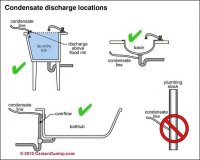ABergman
New Member
Good morning, this is my first post so I’ll start with a introduction of myself. I’m an extreme DIY’er. Basically, by that I mean I DIYer who will get into big projects without fear. But I am not a professional in any specific trade. When Hurricane Florence destroyed my house, I decided to take the reconstruction on myself. I was competent enough to pass the GC exam, but that doesn’t really mean I know what I’m doing as I’m not a practicing GC. My regular career isn’t even in the trades. But the idea behind taking on the project was to learn.
So. During reconstruction, we have encapsulated the attic with 4” of closed cell foam, bringing the attic space into the thermal envelope. I wanted to move the water heater, an AO Smith Heat Pump Hybrid into the attic. My reasoning for this is because of saving space in the garage, and even though the attic is now conditioned space, it will still be warmer than the rest of the house and be a more consistent and optimal place for the heat pump. The heat pump will also help remove moisture from the air. So. That’s my reasoning behind the move.
The problem that I want to ensure I get right is plumbing my condensation lines.
I do not want to run it to the exterior of the house. Actually, I don’t like that my HVAC condensation lines run to the exterior. Yes, I understand that this is the simplest and most common practice.
However, I don’t like the idea of holes in my thermal envelope. Energy efficiency is a large part of this project.
So with that, I would like to run my condensation lines into a drain and am trying to determine the most practical way to do so that will be code compliant.
There is a vent stack directly behind where the water heater will be. This vent is for a sink in a powder room on the first floor. It is a 1.5” vent.
I would like to wye off of this to a trap and create drain for my condensation lines. However, from what I have read my understanding is that this is not allowed. There is also a laundry room near by, another thought that I had was using a condensate pump to pump it into the washer drain.
I have attempted two different local plumbers who both no showed me. There is an extreme shortage of tradesman and GC’s in this area since the hurricane.
So, I am reaching out to this forum board for guidance.
Please excuse my inexperience as I’m here to learn and get it done right.
Thank you,
Alan
So. During reconstruction, we have encapsulated the attic with 4” of closed cell foam, bringing the attic space into the thermal envelope. I wanted to move the water heater, an AO Smith Heat Pump Hybrid into the attic. My reasoning for this is because of saving space in the garage, and even though the attic is now conditioned space, it will still be warmer than the rest of the house and be a more consistent and optimal place for the heat pump. The heat pump will also help remove moisture from the air. So. That’s my reasoning behind the move.
The problem that I want to ensure I get right is plumbing my condensation lines.
I do not want to run it to the exterior of the house. Actually, I don’t like that my HVAC condensation lines run to the exterior. Yes, I understand that this is the simplest and most common practice.
However, I don’t like the idea of holes in my thermal envelope. Energy efficiency is a large part of this project.
So with that, I would like to run my condensation lines into a drain and am trying to determine the most practical way to do so that will be code compliant.
There is a vent stack directly behind where the water heater will be. This vent is for a sink in a powder room on the first floor. It is a 1.5” vent.
I would like to wye off of this to a trap and create drain for my condensation lines. However, from what I have read my understanding is that this is not allowed. There is also a laundry room near by, another thought that I had was using a condensate pump to pump it into the washer drain.
I have attempted two different local plumbers who both no showed me. There is an extreme shortage of tradesman and GC’s in this area since the hurricane.
So, I am reaching out to this forum board for guidance.
Please excuse my inexperience as I’m here to learn and get it done right.
Thank you,
Alan
Last edited:

